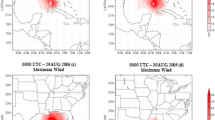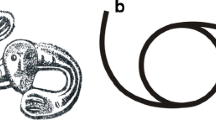Abstract
To establish useful warning systems for hurricanes, it is necessary to accurately predict both hurricane intensity and track. But although the forecasting of hurricane tracks has improved over the past 30 years, the factors that control the intensity of hurricanes are still poorly understood, leading to almost no reliability in forecasts of hurricane intensity evolution. Efforts to improve intensity forecasts have focused almost exclusively on characterizing the dynamical interactions between hurricanes and their atmospheric environment. Here I use a simple numerical model to demonstrate that, in most cases, the evolution of hurricane intensity depends mainly on three factors: the storm's initial intensity, the thermodynamic state of the atmosphere through which it moves, and the heat exchange with the upper layer of the ocean under the core of the hurricane. Such a limited number of controlling factors offers hope that, given an accurate forecast of a hurricane's track, its intensity can be reliably forecast using very simple models.





Similar content being viewed by others
References
DeMaria,M. & Kaplan,J. An operational evaluation of a statistical hurricane intensity prediction scheme (SHIPS). Preprints of the 22nd Conf. on Hurricanes and Tropical Meteorology 280–281 (American Meteorological Soc., Boston, 1997).
Landsea,C. W. & Pielke,R. A. Jr. Normalized hurricane damages in the United States: 1925–95. Weath. Forcast. 13, 621–631 (1998).
DeMaria,M. & Kaplan,J. A statistical hurricane intensity prediction scheme (SHIPS) for the Atlantic basin. Weath. Forcast. 9, 209–220 (1994).
Bosart,L. F., Bracken,W. E. & Molinari,J. Environmental influences on the rapid intensification of Hurricane Opal (1995) over the Gulf of Mexico. Preprints of the 23rd Conf. on Hurricanes and Tropical Meteorology 983–984 (American Meteorological Soc., Boston, 1999).
Price,J. F. Upper ocean response to a hurricane. J. Phys. Oceanogr. 11, 153–175 (1981).
Gallacher,P. C., Rotunno,R. & Emanuel,K. A. Tropical cyclogenesis in a coupled ocean-atmosphere model. Preprints of the 18th Conf. on Hurricanes and Tropical Meteorology (American Meteorological Soc., Boston, 1989).
Schade,L. R. & Emanuel,K. A. The ocean's effect on the intensity of tropical cyclones: Results from a simple coupled atmosphere-ocean model. J. Atmos. Sci. 56, 642–651 (1999).
Khain,A. & Ginis,I. The mutual response of a moving tropical cyclone and the ocean. Beitrage Phys. Atmos. 64, 125–141 (1991).
Emanuel,K. A. The Lagrangian parcel dynamics of moist symmetric instability. J. Atmos. Sci. 40, 2368–2376 (1983).
Schubert,W. H. & Hack,J. J. Transformed Eliassen-balanced vortex model. J. Atmos. Sci. 40, 1571–1583 (1983).
Emanuel,K. A. The behavior of a simple hurricane model using a convective scheme based on subcloud-layer entropy equilibrium. J. Atmos. Sci. 52, 3959–3968 (1995).
Emanuel,K. A. An air-sea interaction theory for tropical cyclones. Part I. J. Atmos. Sci. 42, 1062–1071 (1986).
Bister,M. & Emanuel,K. A. Dissipative heating and hurricane intensity. Meteorol. Atmos. Phys. 65, 233–240 (1998).
Emanuel,K. A. A statistical analysis of tropical cyclone intensity. Mon. Weath. Rev. 127, (in the press).
Price,J. F. Internal wake of a moving storm, Part I: Scales, energy budget, and observations. J. Phys. Oceanogr. 13, 949–965 (1983).
Schade,L. R. A physical interpretation of SST-feedback. Preprints of the 22nd Conf. on Hurricanes and Tropical Meteorology 439–440 (American Meteorological Soc., Boston, 1997).
Bister,M. & Emanuel,K. Hurricane climatological potential intensity maps and tables. (cited 01/05/99) 〈http://www-paoc.mit.edu/∼emanuel/pcmin/climo.html〉/22/03/97)
Levitus,S. Climatological Atlas of the World Ocean (NOAA Prof. Pap. No. 13, US Gov. Printing Office, Washington, DC, 1982).
Ly,L. N. & Kantha,L. H. A numerical study of the nonlinear interaction of Hurricane Camille with the Gulf of Mexico loop current. Oceanol. Acta 16, 341–348 (1993).
Cooper,C. in Proc. Offshore Tech. Conf. 213–222 (Offshore Tech. Conf., Richardson, Texas, 1992).
Acknowledgements
The vertical wind shear data were supplied by Dr. J. Kaplan of the NOAA/ERL Hurricane Research Division. I thank H. Willoughby for comments on the manuscript.
Author information
Authors and Affiliations
Corresponding author
Supplementary information
Rights and permissions
About this article
Cite this article
Emanuel, K. Thermodynamic control of hurricane intensity. Nature 401, 665–669 (1999). https://doi.org/10.1038/44326
Received:
Accepted:
Issue Date:
DOI: https://doi.org/10.1038/44326
- Springer Nature Limited
This article is cited by
-
Observational evidence of overlooked downwelling induced by tropical cyclones in the open ocean
Scientific Reports (2024)
-
Recent increase in rapid intensification events of tropical cyclones along China coast
Climate Dynamics (2024)
-
Marine heatwave as a supercharger for the strongest typhoon in the East China Sea
npj Climate and Atmospheric Science (2023)
-
Atmosphere-upper-ocean interactions during three rare cases of rapidly intensified tropical cyclones over North Indian Oceans
Journal of Oceanography (2023)
-
Interdecadal changes of tropical cyclone intensity in the South China Sea
Climate Dynamics (2023)





